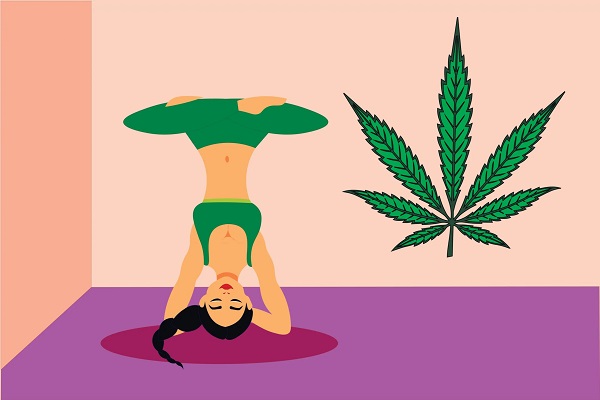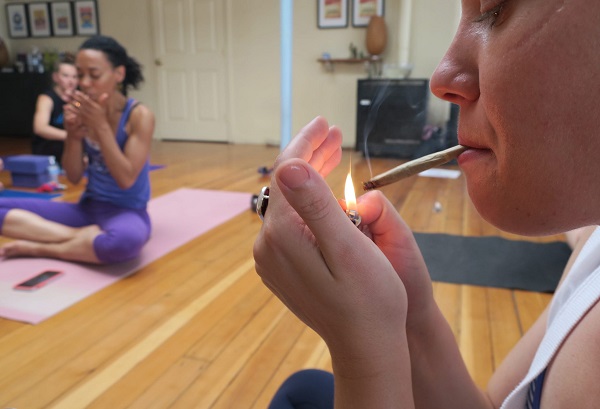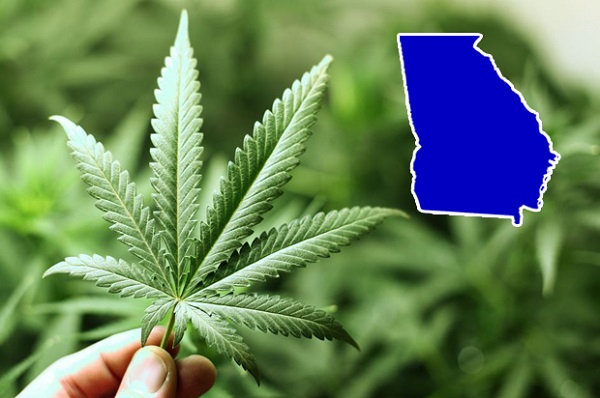Cannabis yoga, also known as 420 yoga, is a sophisticated combination of cannabis and yoga. This modern approach to yoga practice involves vaping or consuming small amounts of marijuana before performing asanas. According to proponents of this new trend in yoga, cannabis promotes greater concentration and accelerates immersion in one’s body.
There are many varieties of yoga, all striving for physical, mental and emotional development. An important aspect is achieving the classic mystical state and experiencing the unity of the subject and object of reality.
Yoga represents union and is traditionally achieved through breathing, meditation, and asanas. These methods aim to achieve a high level of concentration for the experience of unity. Nowadays, people all over the world use cannabis to achieve this concentration and support while practicing yoga.
Cannabis and Yoga

The use of cannabis during yoga is largely an innovation. Although ancient Indian religious texts mention the use of cannabis, the two practices were probably separated. Modern Hinduism and yoga practices, depending on the species, often forbid intoxication during meditation or yoga. However, the Vedas do mention the intoxicating substance Soma, which all yogis must take. Thus, intoxication is not foreign to the tradition, but in India yogis generally do not allow intoxication of yoga or meditation participants.
There are two approaches to the use of cannabis in Ayurvedic philosophy: one makes it a nectar and the other makes it a poison. If cannabis is used incorrectly, it takes on tamasic qualities, becoming a drug that obscures pain or emotion. In Ayurvedic texts it is sometimes described as nectar, perhaps when used for medicinal purposes.
However, when used recreationally, it is a «light switch» that is incapable of inducing spiritual insight. The combination of yoga and marijuana can be compared to salted food; it’s only a slight improvement, says Tanya Pillay, a Toronto-based actress, writer and hypnotist.
Ganja yoga is a relatively new phenomenon that has become popular mostly in American states that are favorable to cannabis, such as California, Washington and Colorado. In Canada, ganja yoga has been around for many years.
It is commonly taught that the combination of cannabis and yoga has its roots in the distant past. This is because Shiva is often depicted with a chilum, the Indian pipe for smoking cannabis. However, although cannabis has a rich history in Hinduism and the Vedas, there is not much evidence that cannabis was used during the practice of yoga. Ganja yoga seems to be a new age discovery.
What does this knowledge give us?

Yoga classes using cannabis are relaxation sessions. Usually teachers and students prefer vaping because it is considered the cleanest way to consume ganja. However, you can also eat it beforehand, but vaping makes it easier to dose and share with the rest of the class.
Typically, participants first get together to vaporize the cannabis and then move on to meditation and yoga asanas. If the instructor is experienced, he or she will also select a variety of cannabis appropriate for the class. For example, some yoga classes are more active, while others focus on recovery, such as yin yoga.
Typically, ganja yoga involves dosing close to microdoses rather than standard doses. For example, very small amounts of tincture are vaporized or consumed. This is because severe intoxication is probably not conducive to concentration or performance of yoga asanas.
In a Forbes article, Elisa Maroni, also known as Cannabis Yoga, talks about her yoga classes using cannabis. In her classes, students can choose from many different products. They continue to microdose until they reach the minimum desired effect, followed by a 45-minute Vinyasa Yin practice.
Cannabis Meditation

Cannabis is not usually seen as a means of increasing concentration, or at least not usually used for that purpose. However, this may be due to the fact that the object of concentration while using cannabis is something less obvious, such as an emotion. Professor Arthur S. Hastings describes this in detail in his article «The Effects of Marijuana on the Mind».
«Marijuana definitely affects the attention process. The most noticeable effect is a reduction in the variety of content a person focuses on. Under the influence of marijuana a person usually perceives fewer objects of attention, including physical objects, actions, social aspects, emotions, etc. We have already noted this effect: a person under the influence of marijuana can be absorbed in an object, event or process to the exclusion of everything else. A stream of fantasies can completely capture a person’s attention. It is the psychological analogue of tunnel vision with expanded tunnel contents».
This is interesting because we rarely associate this behavior with «concentration» or «attention». Rather, such behavior is usually referred to as distraction or an inability to concentrate. In meditation practice, however, such preoccupation with a single thought, idea, or emotion adequately serves the purpose of proper concentration.
In fact, it is full attention to a thought, emotion, fantasy, or feeling is precisely what should connect someone with a sense of «oneness». At least, that is what Zen masters believe, where concentration on a single thought is the passage «through» and largely defines meditation.
This is why Zen masters and true yogis do not usually divide their attention between several stimuli. Rather, they are completely absorbed in one task, ignoring all other stimuli. This is the way of staying in the present moment that cannabis users often talk about. As the old Zen story goes:
When a student asked his teacher:«Master, what is enlightenment?» the master replied, «When hungry, eat. When you are tired, sleep».
Therefore, in the conditions of modern society, achieving this state is extremely difficult. The modern world constantly demands attention in the form of media, work, family and smartphones. This is why people seek a meditative state or «here and now». And this is why such concentration is applicable and relevant in the practice of meditation or yoga.
What is the potential for yoga from cannabis?

Dee Wee Marie was one of the pioneers of cannabis use in yoga in the West. She is the owner of Follow The Bliss Club in Toronto and advocates the use of psychedelics to achieve mystical experiences. In her view, psychedelic remedies are at the heart of all mystical traditions. Dee Wee Marie recommends cannabis, mushrooms and herbs as tools for awakening the «inner God».
However, Lou also notes that she thinks ganja yoga is unlikely to become a popular destination because of public concerns about public acceptance of cannabis use.
She does, however, hope for «widespread acceptance of the use of sacred medicinal plants as spiritual tools». While the combination of cannabis and yoga has great potential if approached correctly, there are also some risks. The most obvious risk is the potential for injury while practicing yoga under the influence of cannabis. Meditating while under the influence of cannabis is one thing, but vigorous physical exercise is quite another. Some may think that cannabis helps you feel better about your body and avoid over-stretching or over-stretching, but for others this may not be the case.
Either way, cannabis has significant potential to improve concentration during meditation. Thus, cannabis may be the missing ingredient for the yoga practice that many people have been looking for.












